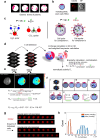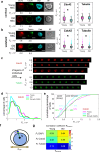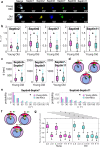Quantitative determination of the spatial distribution of components in single cells with CellDetail
- PMID: 39592623
- PMCID: PMC11599593
- DOI: 10.1038/s41467-024-54638-8
Quantitative determination of the spatial distribution of components in single cells with CellDetail
Abstract
The distribution of biomolecules within cells changes upon aging and diseases. To quantitatively determine the spatial distribution of components inside cells, we built the user-friendly open-source 3D-cell-image analysis platform Cell Detection and Analysis of Intensity Lounge (CellDetail). The algorithm within CellDetail is based on the concept of the dipole moment. CellDetail provides quantitative values for the distribution of the polarity proteins Cdc42 and Tubulin in young and aged hematopoietic stem cells (HSCs). Septin proteins form networks within cells that are critical for cell compartmentalization. We uncover a reduced level of organization of the Septin network within aged HSCs and within senescent human fibroblasts. Changes in the Septin network structure might therefore be a common feature of aging. The level of organization of the network of Septin proteins in aged HSCs can be restored to a youthful level by pharmacological attenuation of the activity of the small RhoGTPase Cdc42.
© 2024. The Author(s).
Conflict of interest statement
Competing interests: The authors declare no competing interests.
Figures





References
-
- Chang, J. T. et al. Asymmetric t lymphocyte division in the initiation of adaptive immune responses. Science315, 1687–1691 (2007). - PubMed
Publication types
MeSH terms
Substances
Grants and funding
LinkOut - more resources
Full Text Sources
Medical
Miscellaneous

